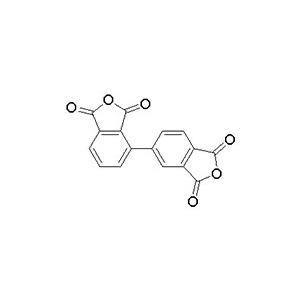Explore Top-Quality α-BPDA with Aure Chemical
2,3,3',4'-Biphenyltetracarboxylic dianhydride (α-BPDA), CAS 36978-41-3, is an asymmetric dianhydride primarily used as a monomer in organic synthesis for high-performance polymers. Its non-symmetrical structure contributes to materials with enhanced properties like higher glass transition temperatures, transparency, and heat resistance compared to symmetric analogs.
Basic Information ofα-BPDA
| Product Name | 2,3,3',4'-BiphenyLtetracarboxylic dianhydride |
|---|
| Abbreviation | α-BPDA |
|---|
| CAS Number | 36978-41-3 |
|---|
| Molecular Formula | C16H6O6 |
|---|
| Molecular Weight | 294.22 g/mol |
|---|
| Appearance | White to almost white powder to crystal |
|---|
| Purity | ≥99% |
|---|
| Package | 1kg/bottle, 20kg/drum, or customized |
|---|
| Molecular formula |  |
|---|
Key Properties
Unsymmetrical structure leads to suppressed intermolecular charge transfer, enhancing transparency in resultant polyimides
Higher Tg and lower melt viscosity than symmetric BPDA isomer, improving processability
Good thermal stability, mechanical strength, and chemical resistance
Used to build transparent, high-performance dielectric films, COFs, and polymer networks
Dual anhydride groups enable polymerization with diamines producing high molecular weight polyimides
Key Applications of α-BPDA
Polyimide Synthesis: Employed to produce polyimides with excellent thermal stability, mechanical strength, chemical resistance, solvent resistance, radiation resistance, and dielectric properties. These are applied in batteries (e.g., lithium-ion cathodes with high capacity of 163 mAh/g and rate capability of 122 mAh/g), electrochromics, and high-performance polymers for electronic materials.
Polyesters and Ester Polymers: Used in creating resins for plastics, textiles, and coatings, leveraging its role in imparting durability and resistance.
Detailed COA / TDS / MSDS are available upon request. Please Contact Us for more information.

